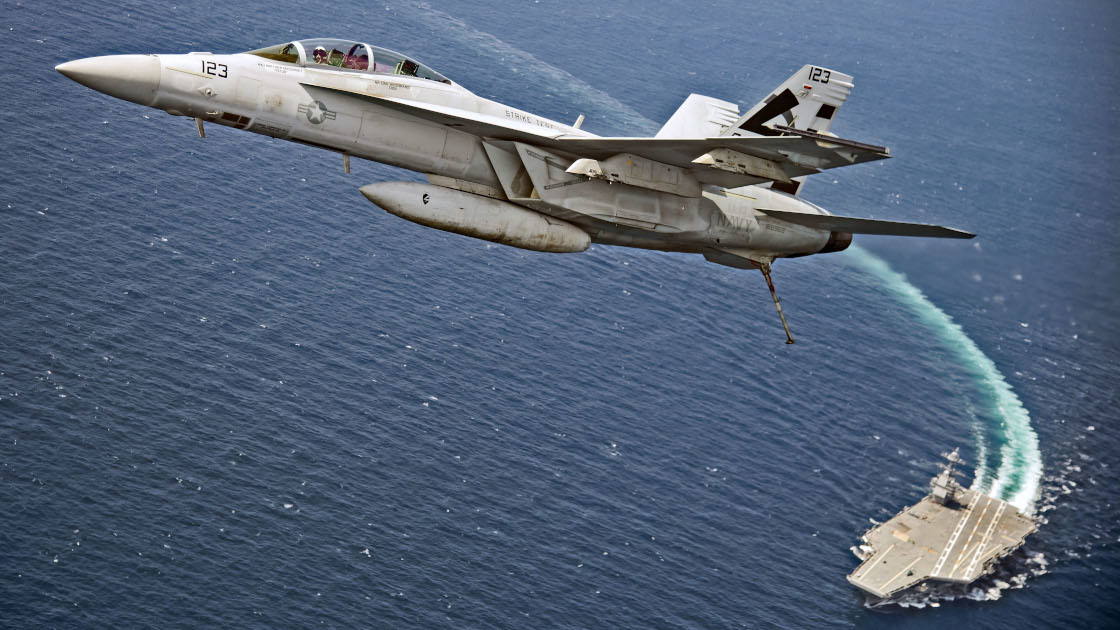

The futuristic war tech in America's newest aircraft carriers
The United States Navy’s next-generation aircraft carriers are rolling off the assembly line, with one massive flagship finally ready to begin operations, one fitting out, and three more on the way.
Though plagued with unforeseen issues in some of their innovative components, these floating fortresses are planned to operate for many decades, offering a tantalizing look at the future of naval technology.
VR-assisted design

The USS Gerald R. Ford is the first aircraft carrier to be designed entirely in 3D. Countless parts, from equipment and machinery to wiring and piping, were represented in a single highly detailed model down to the inch, reducing the likelihood of fitting problems arising in the construction phase.
Design was supplemented with the use of a VR system called CAVE - a room with high-resolution images projected on the walls, ceiling and floor, coupled with motion capture and glasses, allowing designers to physically move through a full-scale model of the aircraft carrier.
25% more nuclear power
The new carrier class has a new heart beating inside it - the A1B nuclear reactor. (A means Aircraft carrier, 1 means it’s the contractor’s 1st generation design, and B stands for Bechtel Corporation, who built it.) Compared to the preceding Nimitz class’ A4W reactors, the Ford-class will generate 25% more energy, all while being smaller and lighter. The technology is more refined, requiring fewer crew to operate and maintain.
The new reactors are so powerful that only half the energy produced is needed by current systems, with the rest set aside for the possible future inclusion of advanced technology, like laser weaponry and electric reactive armour - more on those below.
Electromagnetic Aircraft Launch System
Without a full runway, aircraft carriers need a method of drastic acceleration to get them to flying speed in a short distance. The EMALS technology works by activating and deactivating electromagnets along a pair of beams, generating a magnetic wave which propels a carriage, which in turn accelerates the aircraft to flying speeds - up to 150mph (240 kph).
Traditional aircraft launching catapults use a steam-driven piston to pull the aircraft at high speed. Steam launching systems, introduced in the mid-1950s, are very large, and take a lot of manpower to operate.
Electromagnetic systems are safer, owing to their lack of reliance on pressurised steam, and as a solid state system, are expected to require much less effort to maintain. They also remove the need to pipe steam all over the ship.
They’re also expected to require less energy to operate than a steam system, with a 90% power conversion efficiency, versus 5% for steam.
Because EMALs can finely control the launch sequence as it occurs, and because it places less stress on the airframe, it is able to adapt to modern and future aircraft, allowing it to launch anything from heavy fighter aircraft to unmanned drones.
Advanced Arresting Gear Landing System
Old carriers use hydraulics to capture and decelerate their aircraft, and while functional, they cause huge amounts of stress on the airframe. UAVs can’t be captured this way, as they are unable to handle the stress of a hydraulic system.
The Ford-class uses a software controlled, modular system called AAG to solve these problems - a complex bit of machinery including a “water twister” - paddles in a tank of water to provide resistance and absorb the kinetic energy from the decelerating aircraft. AAG is more reliable, places less stress on aircraft, and reduces operating costs.

Efficiency
The simplification of components and the refinements in design mean that the Ford-class carriers are expected to require approximately 25%, or some 500-800, fewer sailors to operate, leading to significant cost reductions in the long term. More recently, the navy has mentioned a less optimistic 20% reduction in crew, leading some to question whether the Navy’s projections for efficiency gains were overly rosy, although a significant reduction is still expected.
Future tech: Giant lasers and electric shields
Under active development and even onboard testing, high-energy solid-state lasers are expected to be deployed to the fleet. Unlike many other shipboard weapons, laser weapon technology can target ships and aircraft alike, with a goal of also being able to target incoming missiles.
The navy lists modification of the Ford-class aircraft carriers as an option in coming years, so “that they can support SSLs with power levels of 200 kW or 300 kW or more, and/or megawatt-class FELs.” SSLs being solid-state lasers, and FELs, free-electron lasers.
The Navy recently demonstrated the technology on the USS Portland, giving us a spectacular look at the future of shipboard weaponry.
Another exciting technology, under quiet development for use in tanks, is electric reactive armor, mentioned as a possible upgrade to ships like the Ford-class. While not much information is available to the public about the technology, the idea involves two plates separated by some insulating material, charged with huge amounts of electricity.
An incoming projectile impacting the armor would close the circuit between the two plates, channeling huge currents through it, potentially vaporising it or otherwise hindering the ability of the projectile to damage the carrier.
The trouble with innovation
Innovation comes at a cost, and the Ford-class carriers have been no exception. Each ship in the class, of which 2 are built, 1 is under construction, and a further 2 are ordered, come in at around a hefty $12 billion apiece, compared to the preceding Nimitz class’ roughly $8.5 billion price tag.
There’s been no shortage of controversy in the development of the project, mostly around the aircraft launch system, and the arresting gear. EMALs started its life missing reliability goals, and ended up being delayed for years and costing billions more than expected in additional software and hardware development. And the Advanced Arresting Gear system encountered unforeseen problems with its water twister, leading to delays and increased costs.
The teething issues proved surmountable, however. By 2017, the USS Gerald R. Ford successfully tested the electromagnetic launch and landing systems. As of June 2020, over 3000 launches and landings have been performed aboard the USS Gerald R. Ford, with 167 successfully performed in a single day.
The Ford is still gearing up, with around 1,000 sailors joining the crew in recent months to see it through final testing and trials.





Comments
Share your thoughts, post a comment